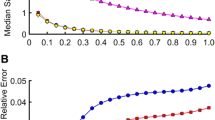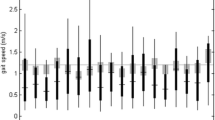Abstract
This paper presents an analysis of spatio-temporal gait parameters during overground walking based upon a method that needs only lower trunk accelerations. Twenty-six healthy young subjects and 15 healthy elderly subjects participated in an experiment where overground walking was studied at different speeds. Accelerations of the lower trunk were measured by a tri-axial accelerometer connected to a portable data logger carried on the body. An analysis of trunk acceleration data produced temporal gait parameters (duration of subsequent stride cycles and left/right steps) and convincing estimations of spatial parameters (step length and walking speed). Typical differences in spatio-temporal gait parameters between young and elderly subjects could be demonstrated, i.e. a limited range of walking speeds, smaller step lengths, and a somewhat higher variability of temporal parameters in elderly subjects. It is concluded from these results that essential spatio-temporal gait parameters can be determined during overground walking using only one tri-axial accelerometer. The method is easy-to-use and does not interfere with regular walking patterns. Both the accelerometer and the data logger can be miniaturised to one small instrument that can be carried on the trunk during hours of walking. Thus, the method can easily be incorporated in current activity monitors so that 24-h monitoring of postures and activities can be combined with assessment of gait characteristics during these monitoring periods. In addition, the presented method can be a basis for more sophisticated gait analyses during overground walking, e.g. an analysis of kinematic signals or muscle activity within subsequent stride cycles.




Similar content being viewed by others
References
Aminian K, Robert P, Buchser EE, Rutschmann B, Hayoz D, Depairon M (1999) Physical activity monitoring based on accelerometry: validation and comparison with video observation. Med Biol Eng Comput 37:304–308
Capozzo A (1981) Analysis of the linear displacement of the head and trunk during walking at different speeds. J Biomech 14:411–425
Gabell A, Nayak USL (1984) The effect of age on variability in gait. J Gerontol 39:662–666
Mulder T, Zijlstra W, Geurts ACH (2002) Assessment of motor recovery and decline. Gait Posture 16:198–210
Odding E, Valkenburg H, Stam HJ, Hofman A (2001) Determinants of locomotor disability in people aged 55 years and over: The Rotterdam Study. Eur J Epidemiol 17:1033–1041
Van Ingen Schenau GJ (1980) Some fundamental aspects of the biomechanics of overground versus treadmill locomotion. Med Sci Sports Exerc 12:257–261
Veltink PH, Bussmann HB, de Vries W, Martens WL, Van Lummel RC (1996) Detection of static and dynamic activities using uniaxial accelerometers. IEEE Trans Rehabil Eng 4:375–385
Wu G, Cavanagh PR (1995) ISB recommendations for standardization in the reporting of kinematic data. J Biomech 28:1257–1260
Zijlstra W, Hof AL (1997) Displacement of the pelvis during human walking: experimental data and model predictions. Gait Posture 6:249–262
Zijlstra W, Hof AL (2003) Assessment of spatio-temporal gait parameters from trunk accelerations during human walking. Gait Posture 18:1–10
Zijlstra W, Rutgers AWF, Hof AL, Van Weerden TW (1995) Voluntary and involuntary adaptation of walking to temporal and spatial constraints. Gait Posture 3:13–18
Acknowledgements
This study was financially supported by the Ministry of Economical Affairs (BTS Grant NR 98206). The author would like to thank Mariëlle Tromp and Karin Lampen for assistance.
Author information
Authors and Affiliations
Corresponding author
Rights and permissions
About this article
Cite this article
Zijlstra, W. Assessment of spatio-temporal parameters during unconstrained walking. Eur J Appl Physiol 92, 39–44 (2004). https://doi.org/10.1007/s00421-004-1041-5
Accepted:
Published:
Issue Date:
DOI: https://doi.org/10.1007/s00421-004-1041-5




